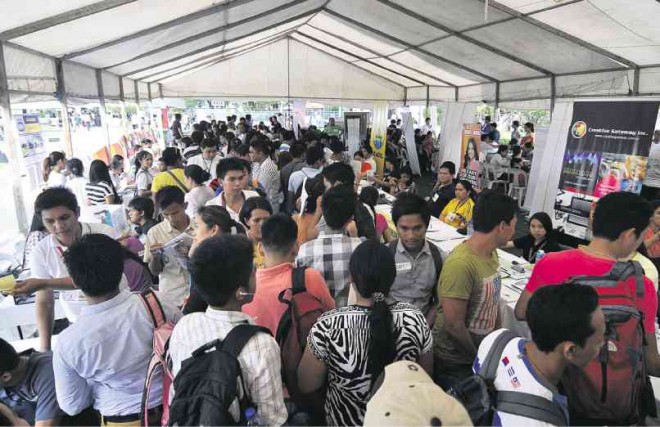The unemployment rate slid to 6.3 percent this year from 6.8 percent a year ago, a preliminary report of the Philippine Statistics Authority (PSA) showed.
Based on the quarterly Labor Force Surveys conducted last January, April, July and October, about 41.3 million “economically active” Filipinos aged 15 and above were either employed or unemployed, the PSA said. The annual labor force participation rate in 2015 stood at an average of 63.7 percent out of the 64.9 million who are 15 years old and above.
The PSA said the annual unemployment rate this year of 6.3 percent, which excluded data from Leyte, was also lower than the 7.2 percent in 2013. This year’s jobless rate is equivalent to 2.6 million jobless Filipinos.
In the surveys it conducted last year, the PSA did not factor in labor data from Leyte, which was then still reeling from the damage brought about by Supertyphoon “Yolanda” (international name: Haiyan) in November 2013.
PSA estimates showed that among the unemployed, 79.8 percent were aged between 15 and 34.
Also, unemployed males, at 63.7 percent of the total, outnumbered unemployed females.
A third of unemployed Filipinos were high school graduates, while over a fifth were college graduates.
As for underemployment, the average annual rate in 2015 was about 18.5 percent, a bit higher than the 18.4 percent recorded in 2014. This translates to 7.2 million underemployed Filipinos.
The PSA defines the underemployed as “employed persons who express the desire to have additional hours of work in their present job, or to have additional job, or to have a new job with longer working hours.”
Of the estimated 38.7 million employed Filipinos this year, the majority or 54.7 percent had their jobs in the services sector; 29.1 percent worked in the agriculture sector; and 16.2 percent were in the industry sector.
In terms of the type of occupation, the biggest proportion of 31.5 percent was comprised of laborers and unskilled workers. Officials of the government and special interest organizations, corporate executives, managers, managing proprietors and supervisors composed 16.3 percent; farmers, forestry workers and fishermen, 12.9 percent; and service workers and shop or market sales workers, 12.7 percent.
Among the employed, 63 percent are full-time workers who worked for 40 hours or more each week, while the rest are part-time workers that go to work for less than 40 hours a week.
